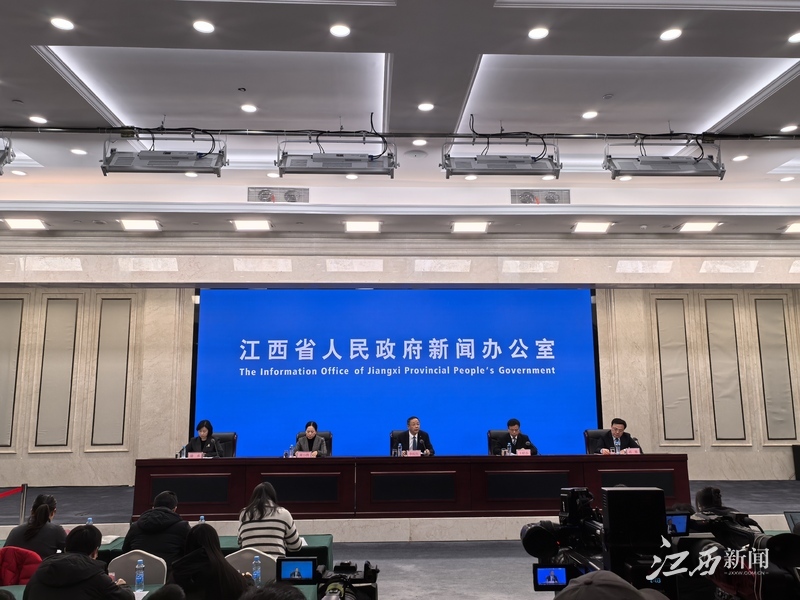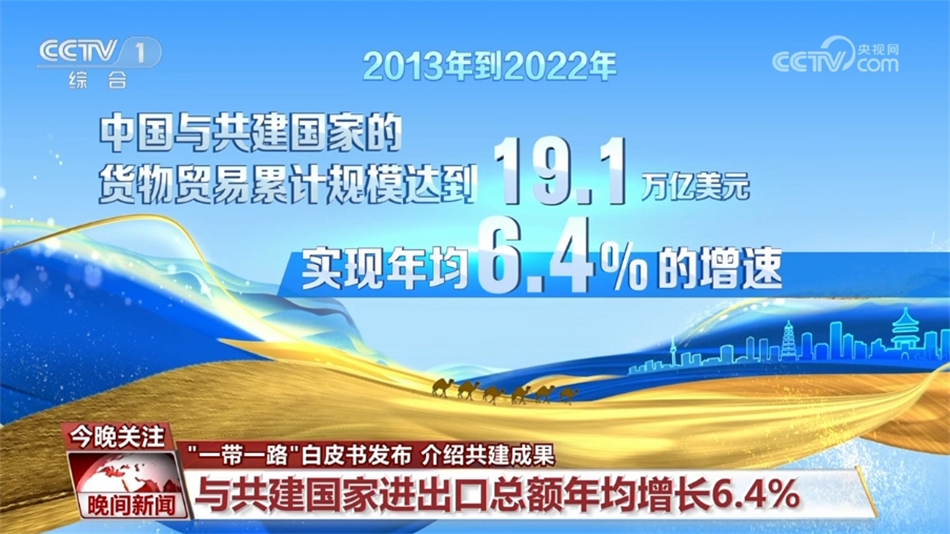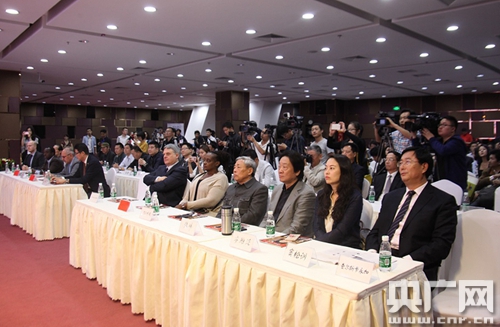Li Xiangyang: Promote High-quality Development Of The “Belt And Road” Through Institutionalization
Li Xiangyang: Promote High-quality Development Of The “Belt And Road” Through Institutionalization
The joint construction of the "Belt and Road" has entered a new stage of high-quality development. In December 2024, at the fourth “Belt and Road” construction work symposium, General Secretary Xi Jinping emphasized the need to focus on promoting high-quality joint construction of the “Belt and Road” mechanism
The joint construction of the "Belt and Road" has entered a new stage of high-quality development. In December 2024, at the fourth "Belt and Road" construction work symposium, General Secretary Xi Jinping emphasized the need to focus on promoting the construction of a high-quality "Belt and Road" mechanism and clarified the requirements for improving mechanisms in nine aspects, including: improving the overall management mechanism for the "Belt and Road" cooperation planning, improving "hard connectivity" and "soft connectivity" We will improve the coordination and promotion mechanism of "Connect" and "Heart Connect", improve the pragmatic cooperation mechanism of the industrial chain and supply chain, improve the international exchange and cooperation mechanism in emerging fields, improve the diversified guarantee mechanism for investment and financing, improve the internal and external collaboration mechanism for risk prevention and control, improve the overseas interest guarantee mechanism, improve the high-level international communication mechanism, and improve the clean Silk Road cooperation mechanism. Mechanisms in all aspects are interconnected and complementary to each other, forming a complete system. Focusing on promoting systematization and institutionalization, promoting high-quality development of the Belt and Road Initiative has become an important task at present and in the future.
Promote mechanism building in development
The Belt and Road Initiative is based on the principle of extensive consultation, joint contribution and shared benefits. It is an important public good provided by China to achieve world peace, stability and prosperity. Compared with the rule-oriented nature of existing international economic cooperation mechanisms, a prominent feature of the Belt and Road Initiative is its development orientation.
The existing international economic cooperation mechanisms, whether they are multilateral cooperation mechanisms or regional cooperation mechanisms, all take the formulation of rules as a prerequisite, that is, set the rules first and discuss cooperation later. Taking the more common free trade area agreements as an example, the first step is to determine which countries are qualified to participate. For example, the Comprehensive and Progressive Agreement for Trans-Pacific Partnership has very high requirements for the qualifications of member states. After determining which countries are eligible to participate, it is necessary to formulate rules for the rights and obligations of member states. In order to resolve possible future trade disputes between member states, a dispute settlement mechanism needs to be formed, and some have also formulated an exit mechanism for member states. After the member states reach consensus on all these rules and mechanisms, the free trade area agreement will officially enter into force. It seems that this approach of solving all the problems that may be encountered in cooperation through rules and mechanisms in advance is conducive to the operation of the cooperation mechanism, but there is also an obvious drawback, that is, many countries that are willing to participate, especially underdeveloped countries, find it difficult to meet the requirements of the rule threshold, and it is difficult to participate in international economic cooperation. Although most regional trade agreements claim to be "open", in fact this "openness" is conditional.
Different from this, the joint construction of the "Belt and Road" initiative embodies the development orientation, actively advocates the concept of win-win cooperation and the correct view of justice and interests, and promotes the realization of great economic integration, great linkage of development, and great sharing of results, that is, discussing cooperation first, and deciding the rules later. We insist that all countries are equal participants, contributors, and beneficiaries, fully respect the differences in development levels, economic structures, legal systems, and cultural traditions of each country, and do not set thresholds based on this. This approach of not presetting rules and thresholds was misunderstood by many people in the initial stage as saying that the "Belt and Road" construction did not need to establish rules and mechanisms. However, as the high-quality joint construction of the "Belt and Road" continues to deepen and become more concrete, the need for rules and mechanisms in practice has become increasingly apparent. Promoting the construction of high-quality joint construction of the "Belt and Road" mechanism has become a key direction.
Development orientation and rules orientation seem to have the same goal in form, and they will eventually move toward institutionalization. However, it needs to be emphasized that the development-oriented Belt and Road Initiative does not preset rules, but promotes mechanism construction in the context of sustained development, reflecting openness in the true sense and providing opportunities for all countries committed to common development to participate in international economic cooperation, thus becoming a highly inclusive global public good and international cooperation platform.
Effectively connect with the global governance system
Promoting high-quality development of the Belt and Road Initiative requires universal recognition from all countries around the world. As a new international cooperation platform, compatibility with the current global governance system is one of the important conditions for gaining recognition. When facing new things, people will first compare them with existing bilateral, multilateral and regional cooperation mechanisms. In this regard, General Secretary Xi Jinping has said many times that the construction of the "Belt and Road" is not about starting from scratch and starting over, but about achieving strategic docking and complementary advantages. In this sense, the “Belt and Road” construction needs to be able to connect with existing bilateral, multilateral and regional cooperation mechanisms and the development strategies of other countries.
Most of the current bilateral, multilateral and regional cooperation mechanisms under the framework of the global governance system are rule-oriented. If there are no relevant rules and mechanisms to promote the construction of the "Belt and Road", it will be difficult to effectively connect with the global governance system. For example, clear tariff concession standards and arrangements for trade and investment liberalization and facilitation are the core content of all free trade area agreements. To comprehensively promote the high-quality development of the Belt and Road Initiative, it is also necessary to improve the institutional construction of relevant aspects. As early as 2014, General Secretary Xi Jinping emphasized that "accelerating the implementation of the free trade zone strategy is a complex and systematic project" and proposed that we need to strengthen top-level design and plan the big chess game, not only to plan for subjugation but also for momentum, and gradually build a free trade zone network that is based on the surrounding areas, radiates the "One Belt and One Road", and is oriented to the world. In practice, China’s cooperation with other “Belt and Road” co-building countries also reflects this institutional connection. For example, the cooperation between China and Southeast Asian countries under the framework of the Belt and Road Initiative includes free trade area arrangements at the regional level, the Lancang-Mekong Cooperation mechanism at the sub-regional level, and the China-Indochina Peninsula Economic Corridor, etc.
Promoting the construction of a high-quality Belt and Road Initiative mechanism is also a realistic option to respond to external challenges. So far, the attitude of some Western countries towards the joint construction of the "Belt and Road" initiative has generally gone through three stages: the first stage is indifference, treating it as a slogan; the second stage is stigmatization, discrediting the implementation of the "Belt and Road" projects; the third stage is institutional hedging, that is, multiple institutional arrangements to hedge the joint construction of the "Belt and Road" initiative have been proposed. These Western countries advocate the "high quality" of their own mechanisms and impose judgments such as "low quality" and "unsustainable" on the grounds of the lack of rules and institutional arrangements in the initial stage of the "Belt and Road" construction. These phenomena remind us that in the future, competition among various international cooperation platforms around the world may be more reflected in rules and mechanisms. To solidly promote high-quality joint construction of the “Belt and Road”, we also need to work hard on mechanism building.
In summary, it can be seen that as the joint construction of the "Belt and Road" enters a new stage of high-quality development, the requirements for mechanism construction have become more prominent. Focusing on promoting the construction of high-quality mechanisms for jointly building the "Belt and Road", especially focusing on improving mechanisms in nine aspects, will help the joint construction of the "Belt and Road" initiative effectively connect with bilateral, multilateral and regional cooperation mechanisms under the framework of the current global governance system, and further enhance the international community's recognition of the joint construction of the "Belt and Road" initiative.
Highlight the requirements for high-quality development
If effectively connecting with the global governance system and actively responding to the institutional hedging of some Western countries are more driven by external influences, then the endogenous driving force for promoting the joint construction of the "Belt and Road" mechanism comes from the requirements of high-quality development.
In 2021, General Secretary Xi Jinping emphasized at the third "Belt and Road" construction symposium that the new development concept should be fully, accurately and comprehensively implemented, with the goal of high standards, sustainability, and benefiting people's livelihood, consolidating the foundation of connectivity cooperation, expanding new space for international cooperation, strengthening risk prevention and control networks, striving to achieve higher levels of cooperation, higher investment efficiency, higher supply quality, and higher development resilience, and promoting the high-quality development of the "Belt and Road" to continuously achieve new results.
Achieving the goals of high standards, sustainability, and benefiting people's livelihood, and promoting the high-quality development of the Belt and Road Initiative to achieve new results, all need to be based on lasting economic benefits. In this regard, institutionalization will play an important role. A study by the World Bank shows that the "hard connectivity" of the "Belt and Road" infrastructure can certainly improve the trade, economic and social welfare of the co-building countries by improving transportation efficiency, but if there is no follow-up "soft connectivity", its benefits will be greatly reduced.
The institutional need to comprehensively promote the high-quality development of the "Belt and Road" is also reflected in the need to upgrade the construction of economic corridors. Both the "Land Silk Road" and the "Maritime Silk Road" are based on economic corridors. The land Silk Road consists of six major economic corridors, and the maritime Silk Road is another form of economic corridor. Economic corridors are not a static concept, but a process of continuous upgrading from low-level to high-level. This process usually goes through four stages: the first stage is to build a transportation corridor with infrastructure as the core, which is an economic corridor in a narrow sense; the second stage is to promote industrialization and urbanization around the transportation corridor, thereby broadening the economic corridor; the third stage is to promote trade and investment liberalization and facilitation on this basis, accelerate the cross-border flow of goods, services and production factors, thereby consolidating the economic corridor; the fourth stage is to coordinate the development strategies of countries along the economic corridor and build a broad economic corridor. At present, most economic corridor construction under the framework of the Belt and Road Initiative is still in the first to second stages. After entering the third and fourth stages, the need for mechanism construction will become more prominent.
Explore practical ways to build mechanisms
Promoting the construction of a high-quality Belt and Road Initiative mechanism is neither a simple copy of the current global governance system nor a reinvention of the existing global governance system. In other words, it is necessary to innovate on the basis of interconnection and complementarity with the existing systems and mechanisms to form a mechanism that is more in line with development reality.
First, promote true multilateralism through open regionalism. The joint construction of the "Belt and Road" initiative is an important practical platform for building a community with a shared future for mankind, and practicing true multilateralism is the essence of the matter. At the same time, we must also realize that building an important mechanism for practicing multilateralism cannot be accomplished in a day. As an important multilateral trade cooperation mechanism after World War II, the General Agreement on Tariffs and Trade had only 23 founding parties. After nearly half a century of development, it only had 76 members when the World Trade Organization was established. Currently, the world has entered a new period of turmoil and change, especially since the United States has wielded the "big stick" of tariffs around the world this year. Economic globalization and multilateralism are facing severe challenges. Promoting the realization of true multilateralism through open regionalism should be a feasible option for high-quality joint construction of the "Belt and Road" mechanism. International economic theory tells us that when regionalism is open, it will become a "stepping stone" to multilateralism; conversely, when regionalism is closed, it will become a "stumbling block" to multilateralism. The development orientation of the joint construction of the "Belt and Road" initiative determines that it practices openness in the true sense, and needs to promote the construction of diversified mechanisms based on the demands of jointly building countries to participate in cooperation.
Second, adhere to the correct view of justice and interests to promote sustainable development. General Secretary Xi Jinping emphasized that “we must adhere to the correct view of justice and benefit, put justice first, give equal attention to justice and benefit, and not be eager for quick success or short-term behavior.” Our country is an advocate and promoter of the “Belt and Road Initiative”, but building the “Belt and Road Initiative” is not our business alone. Putting justice first mainly means respecting the core interests and major concerns of the countries we jointly build. While developing our own interests, we must give more consideration to and take care of the interests of other countries to achieve common development. The emphasis on justice and interests shows that we also emphasize that "development is the last word" and are willing to allow more countries to get on the express train of my country's development. Currently, there are three forms of cooperation under the framework of the Belt and Road Initiative: normal commercial cooperation that gives equal amounts to what is given, foreign aid that only gives but does not take, and profit-sharing cooperation that gives more but takes less. In practice, these three forms of cooperation are intertwined. For different cooperation objects and cooperation projects, how to choose the combination of these three cooperation forms is also an important task in mechanism construction.
Third, build a regional value chain through upgrading economic corridors. Currently, global value chains are becoming shorter and more localized, which is objectively changing the way the global economy operates. At the same time, some Western countries are trying to "decouple and cut off the links" with China under the pretext of "protecting national security." However, China has become a "key link" in the global industrial and supply chains. This kind of plan is impossible to realize. Of course, objectively we also need to face up to this challenge and effectively reduce external risks. In this regard, accelerating the construction of a regional value chain with China as the core is an inevitable choice. The process of promoting the upgrading of economic corridors under the framework of the Belt and Road Initiative is also a process of building a regional value chain. Relying on this, organically combining "soft connectivity" and "hard connectivity" is one of the directions to promote the construction of a high-quality Belt and Road mechanism.
In addition, high-quality joint construction of the "Belt and Road" also requires the promotion of mechanism construction in areas such as risk prevention and control, overseas interest protection, and high-level international communication. In short, mechanism construction is a systematic project, which will be an inevitable requirement for comprehensively promoting high-quality development of the Belt and Road Initiative at present and in the future. It is also a priority task for my country to insist on promoting high-level opening up to the outside world.





